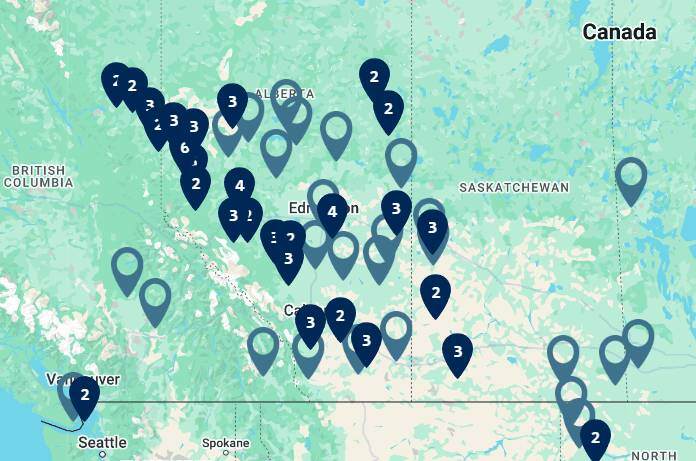June 21 is National Indigenous Peoples Day, a time to honour and celebrate the history, heritage, resilience and diversity of First Nations, Inuit and Métis across Canada. We spoke with Brandi Mercer, SECURE’s Team Lead of Land, who shared what National Indigenous Peoples Day means to her and how she is honouring her history.
Who is Brandi Mercer? I’m a grandmother, mother, daughter and friend. If you ask my friends to describe me, they’d probably say I’m strong, resilient and authentic. I’ve been with SECURE since the merger with Tervita and am currently leading SECURE’s land department.
Outside of work, I’m an avid motorcycle traveler. I have been known to ride over 40,000 km in one season, exploring Alberta, BC, and the Northwestern States. There’s something incredibly freeing about hitting the open road with so many destinations yet to explore.
I am also of Métis heritage which is rooted on my mother’s side. The recent discoveries surrounding residential schools have prompted me to dig deeper into my ancestry, as I strongly believe my mother and grandmother may have been part of the system. This would help to explain some of the struggles they faced, including substance abuse and mental health issues. Unfortunately, my Grandma Lola, whom I was very close with as a child and young teen, passed in 2010 before I had a chance to understand our history and I am currently estranged from my mother, so I may never know the full story and history of what they may have endured.
To date, I have managed to trace my ancestry back to some fascinating figures. My great-great-great-grandparents Felix Akinum dit Shaw and Carline Nipising were from Fort Vermilion and Sturgeon Lake, respectively.

My great-great-grandfather, Donald “Herbie” Taylor, moved west from Manitoba in 1896 to eventually settle in 1912 on the Peace River to what is now known as Taylor, BC. His wife, my great-great grandmother, Charlotte Aneknam Shaw, was educated in a mission school in Alberta and spoke fluent English, French and Cree. Grandpa Taylor worked for the Hudson’s Bay Co. and was a ferryman and trapper, while Grandma raised nine children, one of which would be my Great Grandma Maggie, who unfortunately passed before my birth.
Grandma Maggie’s daughter, Lola, was my dear Grandma Wall. Grandma was very involved with the Aboriginal people in Dawson Creek, working for Nawican Friendship Center and volunteering with many organizations like the Royal Purple, NENAS, Dawson Creek Aboriginal Family Resources and more. She believed deeply that we are all equal, and regardless of our heritage and beliefs, we are all children of the Creator and deserve our place on Mother Earth. We should all walk hand in hand together as one. Prior to her passing, Grandma donated her parents' homestead to build DRIVER HOUSE, named after her parents. Driver House is a housing project by the Native Housing Society that provides affordable housing for Aboriginal Elders and families and was designed and built to represent an eagle in flight. A fun fact is that my Grandma Wall was born on Canada Day.
I was born in Calgary but grew up in Northern BC and Alberta, moving between Prince George, Fort St. John, BC and Fairview, AB. At 16, I found myself back in Calgary. Deciding to become a land professional came later in life for me. I was a stay-at-home mom looking to pursue a stable career. My mother stumbled upon a newspaper ad for a program called “Petroleum Land Administration for Urban Aboriginals” designed to provide an opportunity for those of aboriginal ancestry to receive training for a sustainable career. The program was a joint initiative between Alberta Human Resources and the Nations and was incredibly competitive. There were only 15 spots available, 10 reserved for First Nations and 5 for those of Métis heritage. After applications and interviews, I was thrilled to be selected and embarked on a six-month journey of intensive study, life skills training and a practicum within an oil and gas company. Our graduation was put on through Chinook Lodge and had a large Indigenous component to it. Métis students received an official Métis sash and sweetgrass braid along with the traditional diploma. There was a Grand Entrance with all the nations flags, drummers and dancers and a wonderful meal of traditional foods. Six months after completing the program, I was hired into my first land role. Over the years, I gained valuable experience in global operations, growing into larger roles that have led me here to SECURE.
The Métis Sash
The Sash is a visible symbol of Métis identity. They were originally created from European wool and using a First Nations finger weaving technique. Historically, sashes had many practical purposes and today is worn as ceremonial dress to honour achievements and recognize Métis heritage. The colours of the sash are significant:
Red – for the Métis blood that was shed throughout years while fighting for their rights
Blue – for the depth of our spirits
Green – for the fertility of the Métis Nation
White – for the connect to the earth and Creator
Gold – for prosperity and honor
Black – represents colonization, loss of language, cultural disconnect and residential schools
Indigenous culture has played a significant role in my life, although it wasn’t always that way. Growing up, my Métis heritage was something I knew of but didn’t actively engage with. It wasn’t until my mother remarried to a Métis gentleman, a Sundancer who practiced traditional ways, that I began to learn more about my culture. I didn’t learn alone, in fact my daughter embraced our heritage too, enrolling in Métis dancing with the Calgary Stardancers, where she performed at the Calgary Stampede Parade and competed at Batoche Days.
National Indigenous Peoples Day and National Indigenous History Month are vital for reconciliation. I think having these days reminds everyone that there are people and history that still needs to be investigated. It’s such a beautiful culture that is slowly getting lost as our elders are passing. The traditions, medicines and teachings can help us all in our daily lives. Sadly, because so much was verbal and not written, it is being lost as time goes on. I think acknowledgement of National Indigenous Peoples Day and National Indigenous History Month provides an opportunity for everyone to research and put these things in writing so that future generations know the history. Canada has a rich history that should be remembered, cherished and learned from.
I believe SECURE and other companies can commemorate these days by organizing events that include food, art, dancing and lectures. Guest speakers from various Nations could share their knowledge on topics like herbs, beading and drumming, creating a vibrant mini-conference atmosphere. As for my plans on National Indigenous Peoples Day, I’ll be attending celebrations at Nose Creek Park in Airdrie that have been organized by Circle Connections for Reconciliation, an organization that was spearheaded and now co-chaired by my dear friend Adrian Pruden. The event promises Elder blessings, prayers, music, dancing and food—a perfect way to honour our heritage and look forward to the future.






